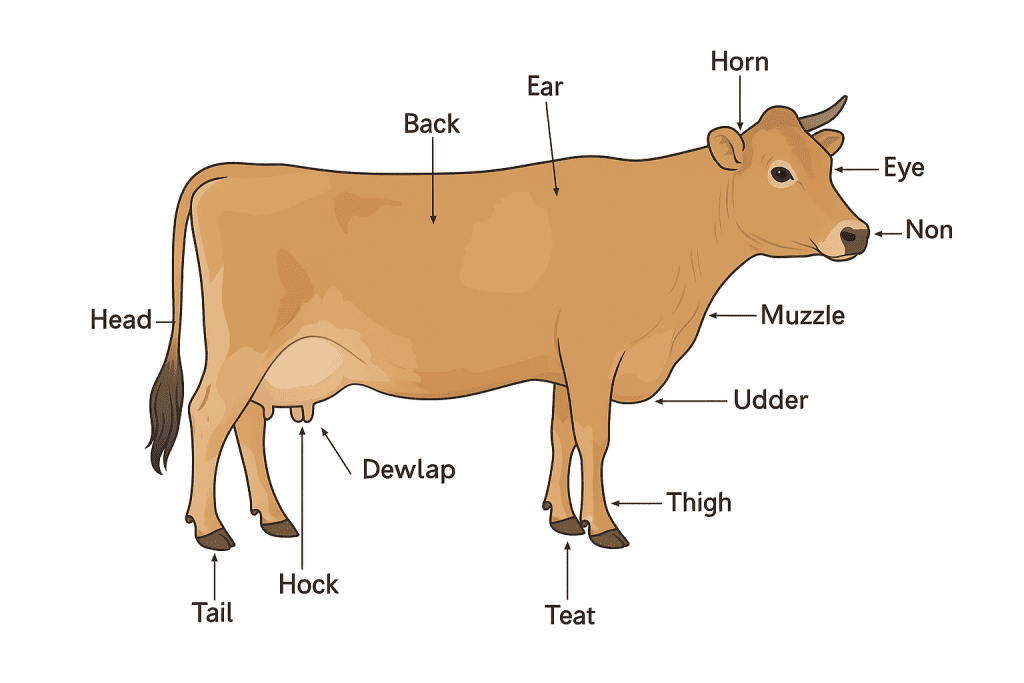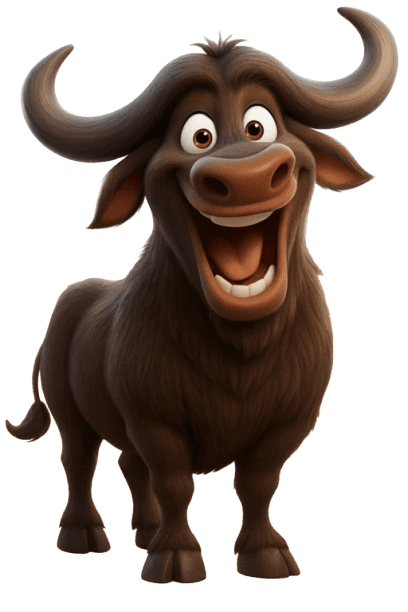Jersey Cows – A Complete Guide for Dairy Farmers
- Home
- Cattle Knowledge
- Jersey Cows – A Complete Guide for Dairy Farmers
Introduction
Jersey cows are among the most popular dairy breeds worldwide, known for their high-quality milk, rich butterfat content, adaptability, and lower maintenance cost. Originating from the Island of Jersey (UK), this breed has spread across Europe, the United States, and Asia, including India, where it has become a preferred choice for many dairy farmers.
Characteristics of Jersey Cows
Average Lifespan
A Jersey cow generally lives 15–20 years if properly cared for. On average, their productive milking life is 7–10 years, which makes them a long-term asset for farmers.
Size and Weight
Jersey cows are smaller than Holsteins or indigenous Indian breeds.
Adult cows: 360–500 kg
Adult bulls: 600–700 kg
Despite their smaller size, they are highly efficient milk producers.
Body Color and Markings
Jerseys usually have a light brown, fawn, or reddish coat, sometimes with white patches. Their black nose, large eyes, and small size make them easy to identify.

Milk Quality: Butterfat and Protein Levels
One of the strongest points of Jersey cows is their milk quality.
Butterfat: 4.5–5.5% (much higher than Holsteins at 3.5%)
Protein: 3.5–4%
This makes Jersey milk excellent for ghee, butter, cheese, and paneer.
Milk Yield & Efficiency
Average Milk Production Per Lactation
On average, a Jersey cow produces 4000–6000 liters per lactation (305 days). While Holsteins produce more in volume, Jerseys produce higher-value milk due to its fat and protein content.
Factors Affecting Milk Yield
Nutrition: Balanced diet with fodder, silage, and concentrates
Age & Stage: Peak production usually occurs in the second and third lactation
Health & Genetics: Healthy cows with good breeding lines produce more
Climate: Jerseys adapt well to warm climates compared to Holsteins
Why Jersey Milk is Preferred
Because of its creaminess and high fat content, Jersey milk is best for:
Butter and ghee production
Paneer and cheese manufacturing
Ice cream and flavored milk
Feeding & Nutrition Management
Recommended Fodder and Feed
A Jersey cow needs a balanced ration of:
Green fodder: Napier grass, maize, berseem, sorghum
Dry fodder: Hay, straw
Concentrates: Grains, oilseed cakes, bran
Vitamin and Mineral Requirements
Supplements are essential for:
Calcium & Phosphorus (for bone and milk production)
Vitamin A, D, E (for reproduction and immunity)
Mineral mixture (for balanced growth and milk yield)
Seasonal Feeding Adjustments
Summer: More green fodder, water, and mineral salts to prevent heat stress
Winter: Energy-rich concentrates to maintain body warmth
Care & Health Management
Calving Management and Gestation
The gestation period of a Jersey cow is about 278–285 days (9 months). Proper care before and after calving ensures a healthy calf and consistent milk production.
Common Diseases and Prevention
Mastitis – Maintain udder hygiene
Milk fever – Provide calcium supplements
Foot and mouth disease – Vaccination and biosecurity measures
Vaccination Schedule
Essential vaccines include:
FMD (Foot and Mouth Disease)
HS (Hemorrhagic Septicemia)
BQ (Black Quarter)
Brucellosis
Hygiene and Hoof Care
Regular hoof trimming to prevent lameness
Clean housing reduces bacterial infections
Housing & Environment
Ideal Shed Design and Ventilation
A good shed must provide:
Cross-ventilation for fresh air
Sloped flooring for easy drainage
Adequate space (40–50 sq. ft. per cow)
Bedding and Flooring
Use dry straw or sand for bedding
Floors should be non-slippery and easy to clean
Protection from Climate
Summer: Fans, sprinklers, and shade trees
Winter: Warm bedding and proper enclosure
Breeding & Genetics
Natural vs Artificial Insemination
Natural service is cheaper but riskier for disease spread
Artificial insemination (AI) allows better selection of superior genetics
Crossbreeding Practices
Crossbreeding Jerseys with local breeds improves:
Heat tolerance
Disease resistance
Milk fat percentage
Genetic Traits
Farmers prefer Jerseys for:
High fertility
Early maturity
Efficient feed conversion
Cost & Profitability
Cost of Rearing
Feed: 60–70% of total cost
Housing & healthcare: 20–30%
Initial purchase price in India: ₹50,000 – ₹90,000 depending on age and lactation stage
Return on Investment
A single Jersey cow yields 10–20 liters/day with 4.5–5% fat milk
Higher milk fat means better market prices
Value-added products (ghee, paneer, butter) increase profit margins
Price Comparison with Other Breeds
Jersey: Lower cost, high-fat milk
Holstein Friesian: High milk yield, lower fat
Indigenous breeds (Gir, Sahiwal): Good for organic and A2 milk markets
Comparison with Other Dairy Breeds
Jersey vs Holstein Friesian
Holstein: Higher milk yield (25–35 liters/day) but lower fat (3.5%)
Jersey: Lower yield (15–20 liters/day) but higher fat (4.5–5.5%)
Jersey vs Indigenous Breeds
Jerseys adapt better in hot climates compared to Holsteins
Indian breeds (Gir, Sahiwal) produce A2 milk, but Jerseys produce creamier milk
Dairy Products from Jersey Milk
Butter & Ghee – High butterfat makes them ideal
Paneer & Cheese – Better yield and taste
Ice Cream – Creamy texture preferred by consumers
Adapting Jerseys to Local Conditions
Jerseys perform well in Indian rural areas if given proper feed and housing
Water availability is crucial for high yield
Market demand for high-fat milk ensures consistent income
Best Dairy Farm Practices for Jerseys
Keep detailed records of milk yield, health, and breeding
Use modern equipment like milking machines, milk coolers, and fodder choppers
Cow dung can be used for biogas or organic fertilizers
History & Origin of Jersey Cattle
Jersey cows originated from the Island of Jersey (UK) in the 1700s. Over time, they became popular in the USA, Europe, and Asia due to their hardiness, fertility, and milk quality. Today, they are one of the most profitable dairy breeds globally.
FAQs About Jersey Cows
How much milk does a Jersey cow give per day?
A healthy Jersey cow gives 10–20 liters per day depending on diet and management.
What is the fat percentage in Jersey milk?
Jersey milk contains 4.5–5.5% fat, making it ideal for ghee and butter.
What is the price of a Jersey cow in India?
On average, Jersey cows cost ₹50,000 to ₹90,000 depending on lactation stage, health, and location.
Are Jersey cows profitable for small farmers?
Yes, Jerseys require less feed, produce high-fat milk, and adapt well to Indian climates, making them profitable for small and medium farmers.
Which is better: Jersey or Holstein?
Jersey: High-fat milk, lower feed cost, better in hot climates
Holstein: Higher milk quantity but lower fat
👉 Apply for a Cattle Loan.
TabelaWala – White Gold Livestock Pvt. Ltd. — Empowering farmers,
App Downloads
Advisor’s Team

Social Media Reach

Happy Customers



Subscribe To Our Newsletter
Welcome to TabelaWala, brand name of White Gold Livestock Private Limited, the ultimate marketplace for dairy farmers looking to buy or sell cows and buffaloes online as well as offline.

+91 830 570 6703
Got Questions? Call us 24/7


